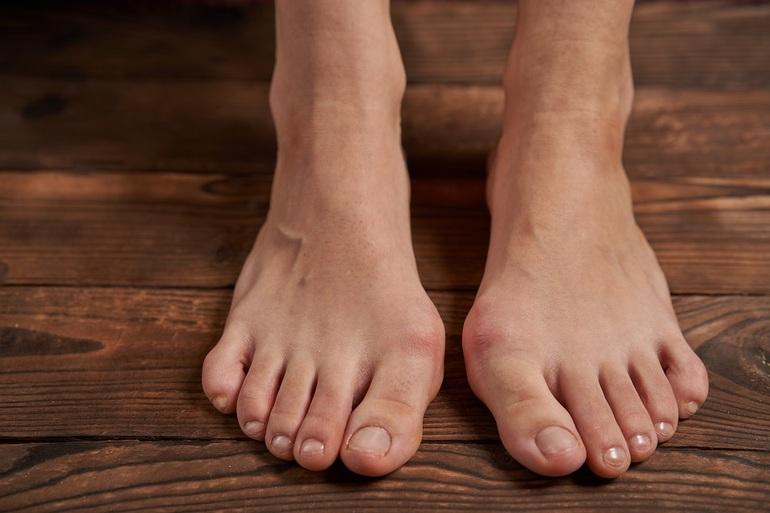A bunion is a condition in which a bony protrusion forms at the joint that connects the foot to the big toe. Typically, the big toe will bend towards the second toe with the bunion.
The most common myth is that most people think that bunions are caused by excessive bone development. While this may be accurate in some instances, the bunion is generally a dislocation at the big toe joint, making the bony structures bulge against the skin.
After bunion surgery, you’re not allowed to wear shoes with narrow heads or the small-size shoes. That now brings us to the topic of our discussion, which is “does shoe size change after the bunion surgery?” The answer is yes. Bunion surgery changes the shoe size.
Sometimes after the bunion surgery, you will realize that the big toe gets shorter, making you go for the smaller shoe sizes that are still comfortable with the newest conformation.
Big toes get shorter if the joint is fused during the procedure and the big toe is permanently linked to the mid foot. Osteotomies also reduce the size of the big toe.
To correct the deformity and control pain caused by bunion disorder, bunion surgery is done. According to many patients who have undergone the therapeutic procedure of bunion surgery, there is a significant reduction of pain after the surgery.
In addition, there is a worthwhile improvement in big toe beauty since it’s made to align appropriately with the foot.
How the Shoe Size Change After the Bunion Surgery
There is a slight difference in the bunion surgery outcome. Therefore the degree of shoe size change tends to vary from one individual to another.
The level at which the shoe size changes after the bunion surgery depends on the intensity of the bunion and the other factors that contributed to the surgery. Due to the variation, the changes in shoe size after the bunion surgery can go either way.
After the bunion surgery, the foot might swell, increasing the shoe size to accommodate the enlargement. On the other hand, if there is loss of the metaphyseal bone after the bunion surgery, the shoe size will decrease. Other additional procedures tend to make the feet appear smaller in other exceptional cases.
According to orthopedics specialists, people with bunions should wear expertly crafted shoes with broad and deep toe boxes. Even if the shoe fits properly from the back, the front area should have enough space.
After bunion surgery, it’s essential to wear accommodating shoes of the right sizes. Correct shoe sizing plays a vital role in ensuring that the big toe and the feet heal uniformly after the surgery.
If the bunion areas and your shoe size are in constant conflict, the healing process is significantly delayed, and the risk of complications after the surgery is increased.
When to Wear the Normal Shoes after the Bunion Surgery
You can wear the regular shoes two weeks after the bunion surgery, depending on the type of procedure done. Notably, most patients who have undergone bunion surgery are not allowed to walk with the aid of their feet until the six weeks are over.
Generally, it takes most people around two months to start wearing regular shoes because the bunion repair takes time to heal. The swelling also, which is typically common, takes time to resolve.
The bunion surgery patients can wear athletic shoes or sneakers after four weeks. To wear sandals or dress shoes, you need to wait for approximately ten weeks. However, everything boils down to fit into the individual’s healing process despite the variations.
If you can wear wide shoes with larger toe boxes, you will have a quick recovery after the bunion surgery. It’s better to use athletic shoes rather than high heels to help you in pain relief and good alignment of the bones after the repair.
In addition, you can opt to cushion the bunions with the aid of protective pads to keep the big toes stable in the proper position. There is a special type of shoe that you can wear for around 3 to 6 weeks, and it will speed the healing process.
After the bunion surgery, remember that you’re not allowed to continue wearing pointed shoes designed with narrow fronts.
The Types of Shoes That You Can Wear After the Bunion Surgery
- Mary Jane Sneaker
If you’re looking for all-around comfort when walking after bunion surgery, the Mary Jane sneaker is a perfect one for you. The revolutionary outsole is made of tried-and-true materials.
Another feature that makes it unique is the addition of cushion insoles for a sweeter feel and optimal comfort. The shoe’s foot-bed may be removed to make room for customized orthotics.
- New Balance Sneakers
The durability, more room for bunions, and exceptional cushioning and comfort are positive aspects of New Balance shoes. However, it is rather costly.
The base is broader than other shoes, and the sole is adequately cushioned, providing a highly stable ride. New Balance sneaker’s laces have a fair amount of elasticity; you may easily adjust to fit your foot.
If your feet are in the “between” size range and you have trouble deciding which size to get, go for the larger size.
- Crocs
Crocs are inherently comfortable and light, making them an excellent choice for post-bunion surgery footwear. Croc is a comfy shoe with an open sole, so it doesn’t come into the category of shoes that tend to aggravate bunion pain.
After overcoming the foot injuries, footballers reportedly admitted to finding long-term comfort from Crocs. That is due to the fact that they have a wide toe box and adequate arch support.
Wearing non-slip shoes with a rubber sole, such as Crocs, is one of the reliable recuperation techniques recommended by doctors. Crocs, it appears, are what you require right now to heal your bunion.

